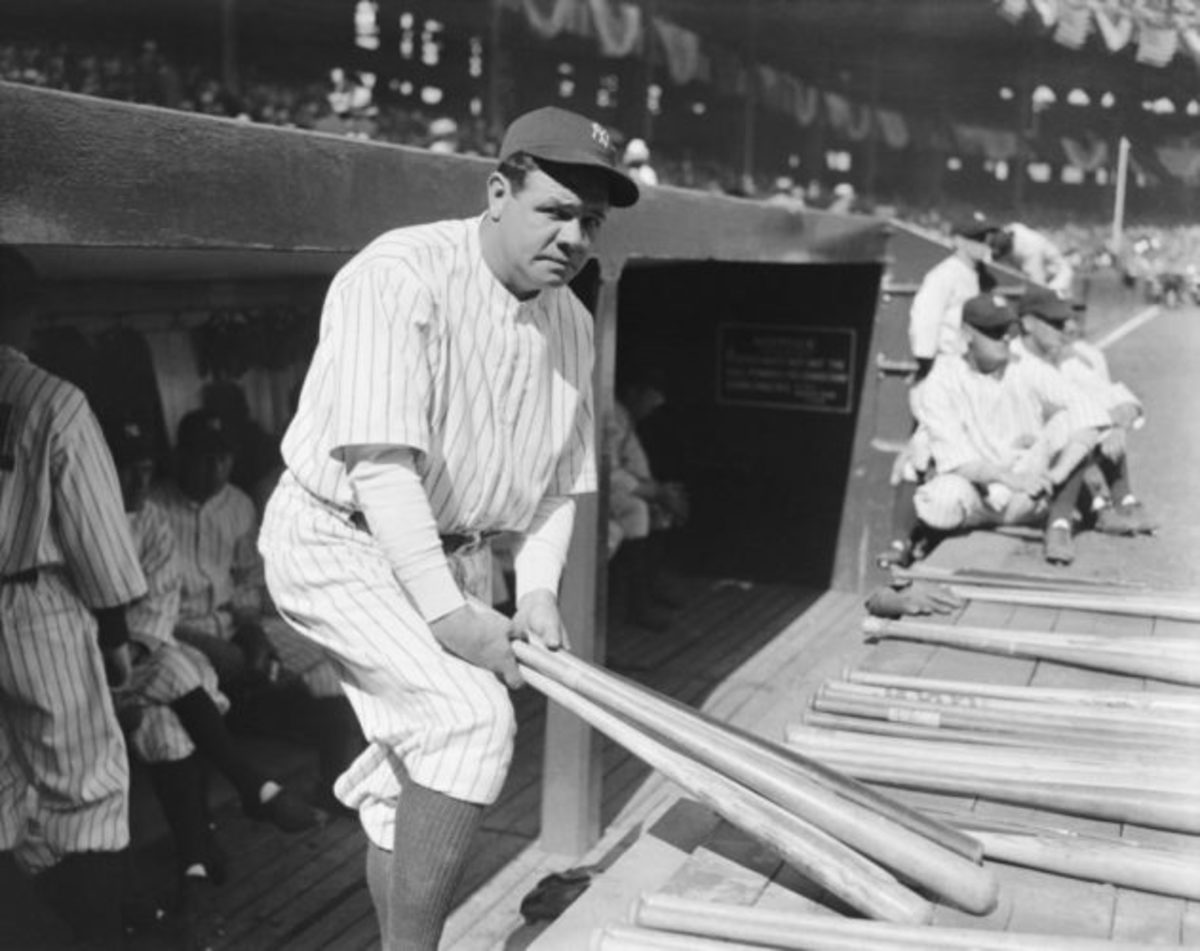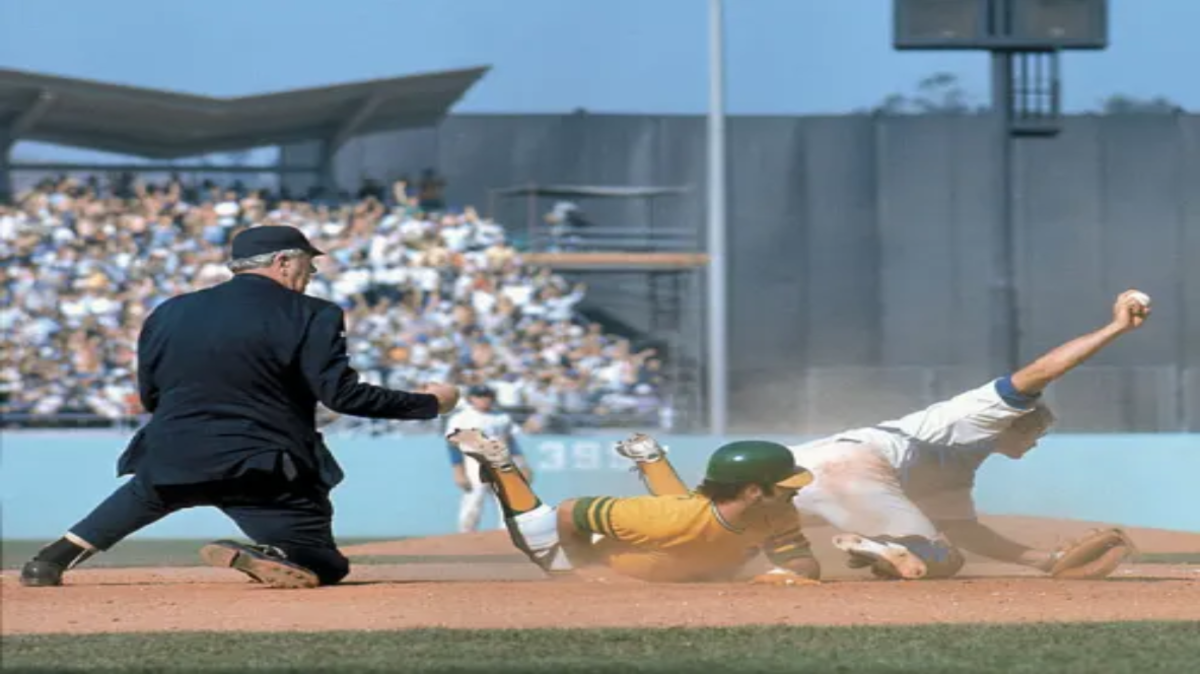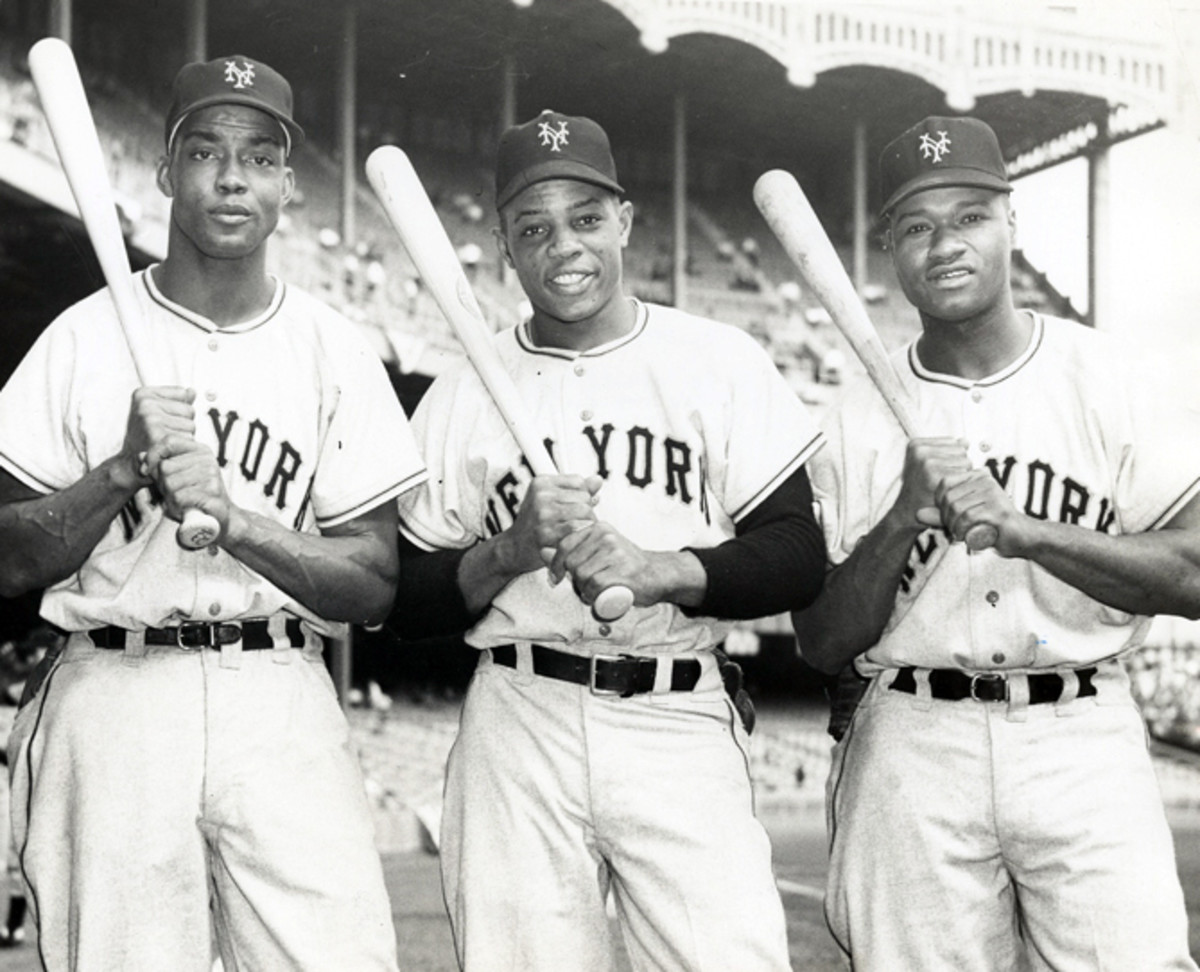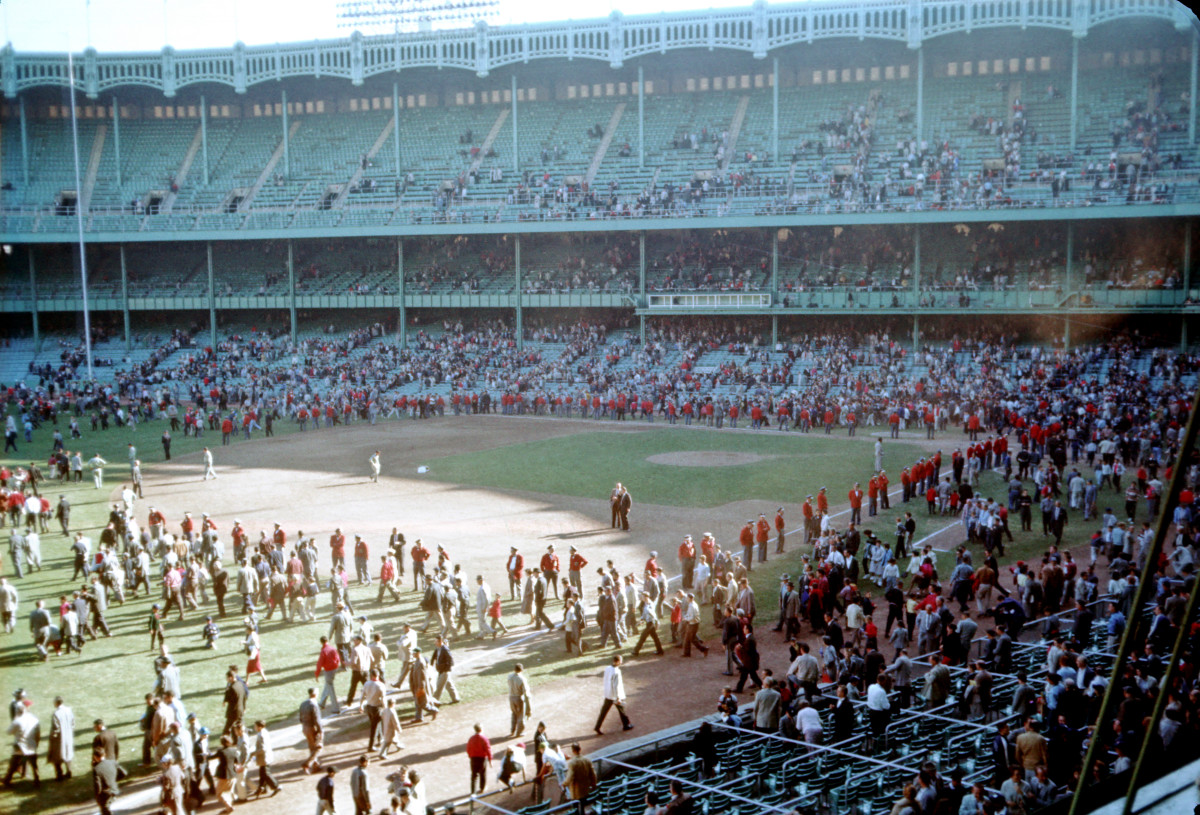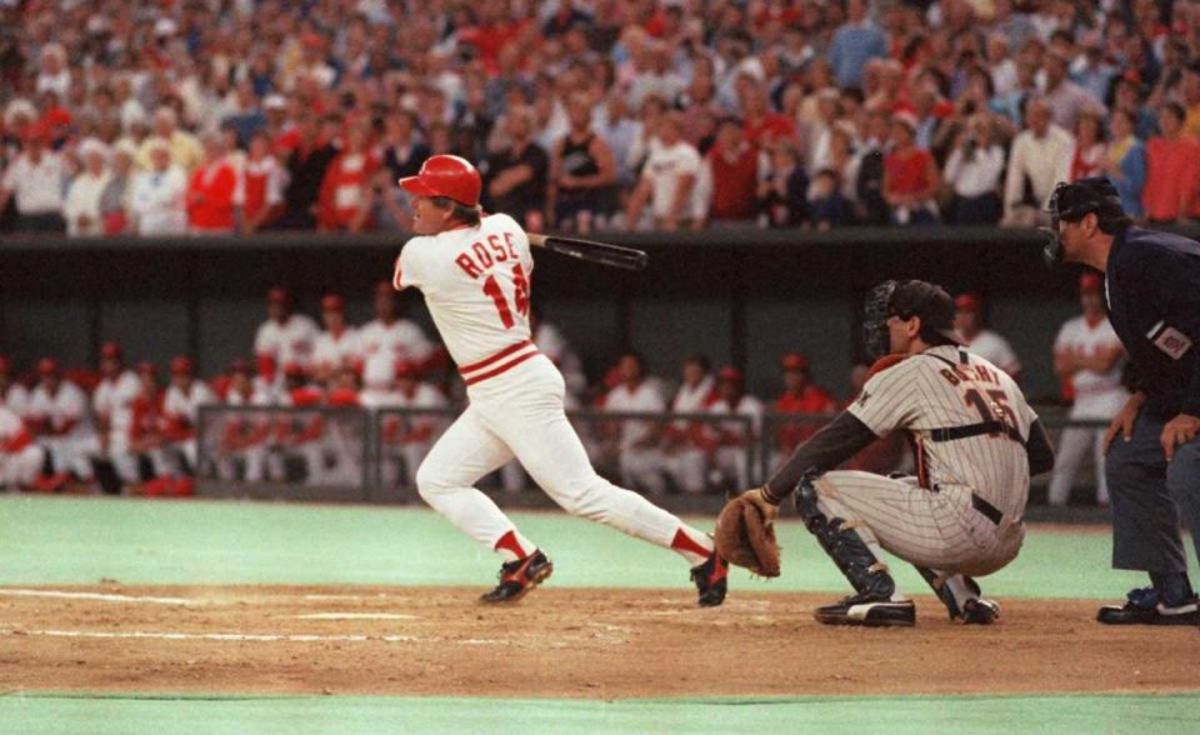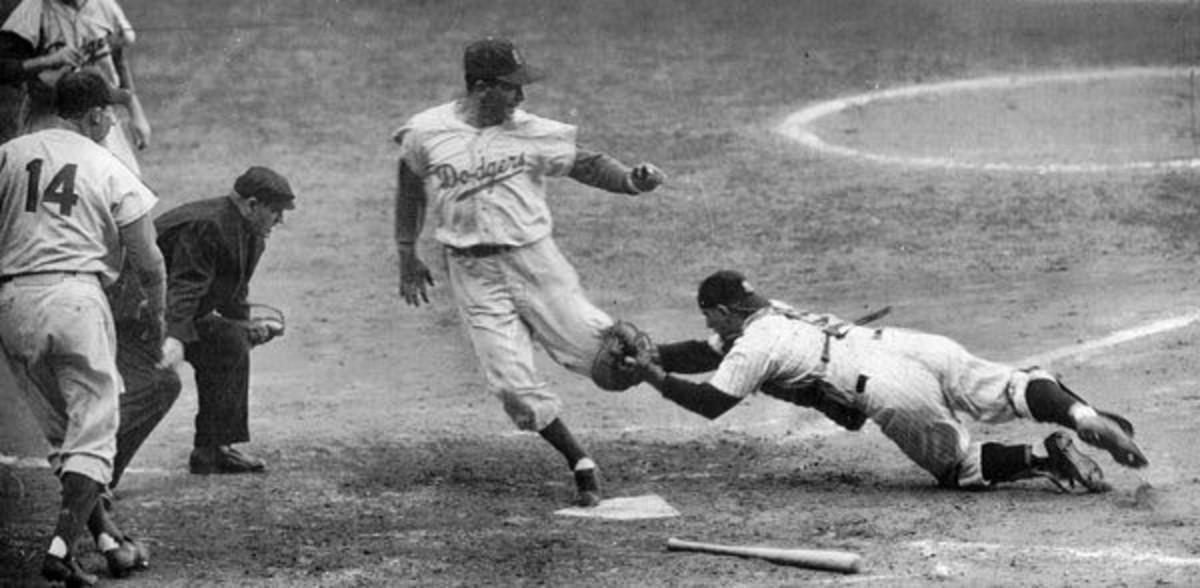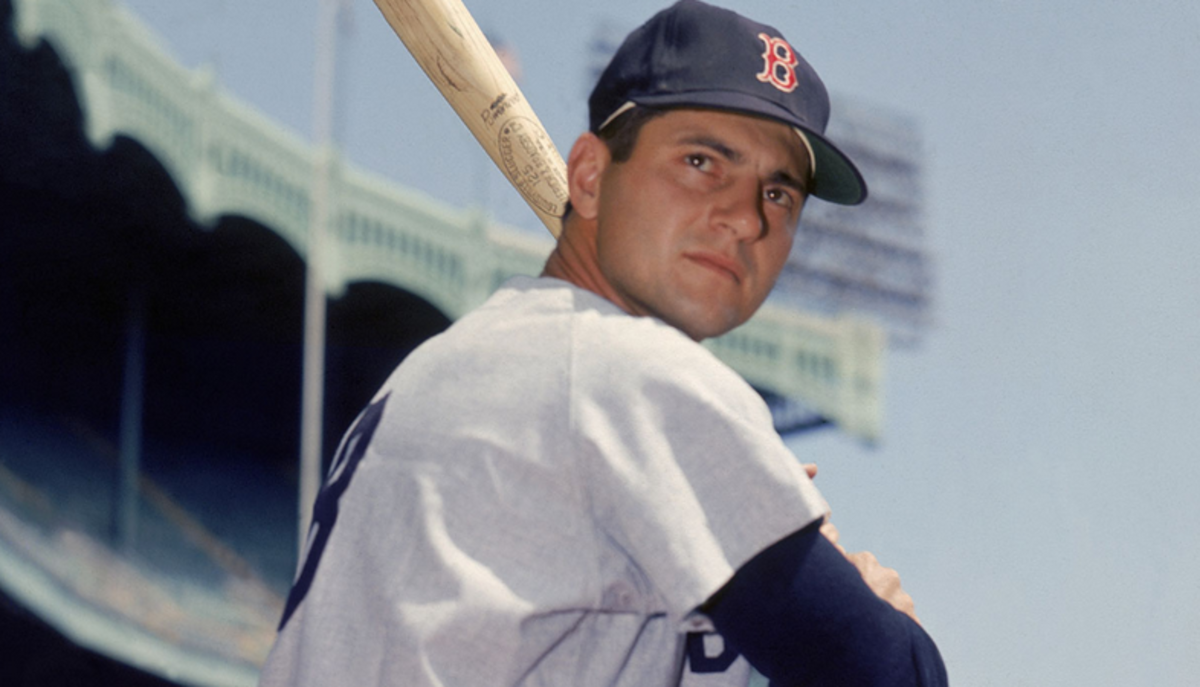- HubPages»
- Sports and Recreation»
- Team Sports»
- Baseball
Been Caught Cheating: Ejected Pitchers, Before and After
Pineda Gets Caught
What Will Pineda Do?
Michael Pineda got his hand caught in the cookie jar recently The young Yankee pitcher foolishly put a very visible amount of pine tar on his neck. That was baffling enough, but when you consider how observers accused him of using pine tar illegally in a previous start against the Red Sox in the same month, this move was plain stupid.
Pineda was suspended for 10 games. The big question is what to expect when he comes back. There’s not a lot of “before” to compare to, because he’s missed two full seasons and only had a handful of starts this year.
Amazingly, that’s not the first time a guy got caught cheating after missing two full years.
And, if you’re worried that he’ll struggle, the numbers seem not too terrifying for guys who got caught. Many of them were better the rest of the year. For a few, it was even a turning point. But overall, they didn't change -- yet their win-loss record did.
Before and After, 10 and 25 Games
Games
| W-L
| IP
| K
| BB
| ER
| ERA
| |
|---|---|---|---|---|---|---|---|
10 games prior
| 195
| 58-46
| 875 2/3
| 440
| 240
| 361
| 3.71
|
10 games following
| 195
| 61-58
| 915 2/3
| 470
| 291
| 385
| 3.78
|
25 games prior
| 463
| 142-116
| 2,128
| 1,075
| 610
| 897
| 3.79
|
25 games following
| 463
| 134-138
| 2,207 1/3
| 1,128
| 672
| 921
| 3.76
|
The total results for all pitchers in the 10 games prior to being caught, not counting the ejection game, and the 10 games following, as well as the 25 games prior and following. Only 13 games are counted for Joe Niekro in the 25-game totals because
Slim Sallee
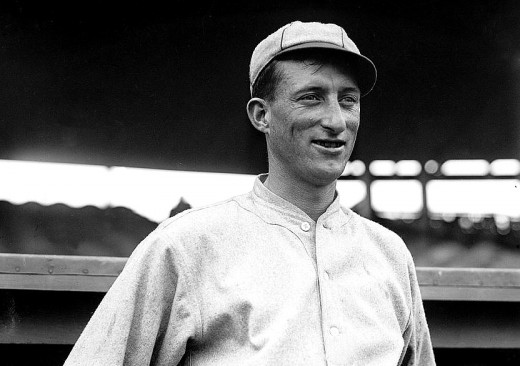
Slim Picked On
Slim Sallee came up with the Cardinals in 1908 and put in many successful years with St. Louis and then the Giants. He won at least 14 games every year from 1911 through 1917. He joined the Reds in 1919 and went 21-7 with a 2.06 ERA.
He pitched nine games for the Reds in 1920 before being caught and ejected in the eighth inning of the game on June 11. In some ways, like Pineda, he had only himself to blame. According to SABR’s biography of Salle, “In 1920, two days after a lengthy interview expressing his objections to baseball’s new rules prohibiting pitchers from using substances on the ball, Sallee was ejected from a game and subsequently suspended ten days for using rosin to grip the ball.”
In nine games that year, counting June 11, Sallee was 2-4 with two saves and a 3.52 ERA. He returned on June 24 and went on to pitch 12 more games for the Reds and five for the Giants. In that time he went 4-2 with a 2.82 ERA.
Maybe Sallee complained about the changes because he was 21-7 for the champs and didn’t want to risk having a good thing messed with, especially since he just turned 35 and foresaw the end of his career.
Sallee had one year left in him, going 6-4 with a 3.64 ERA for the champion Giants. He retired with a 174-143 record.
Dave Danforth
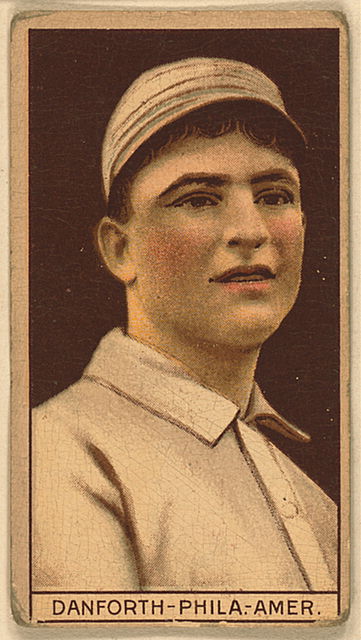
Danforth's Bio
- Dave Danforth
The biography of Dave Danforth at SABR. There are many great biographies on this site.
Danforth Doubles Down
Like Pineda and Sallee, you’ve got to wonder what Dave Danforth was thinking. Danforth was the second and third guy caught and ejected for doctoring the ball. He cut the ball on July 27, 1922 and discolored it on Aug. 1, 1923.
Why? Well, Danforth is a bit of a mystery. His SABR biography is fascinating, calling him a “Forrest Gump of the game.” He was, admittedly, the inventor of the shine ball, which became illegal in 1920. But he claimed never to have thrown an illegal pitch, that he changed his habits when the rules changed.
He was 28-29 with a 3.54 ERA from 1911-19, when doctoring of the ball was legal. Then he was in the minors for a few years, returning to the majors in 1922 with the St. Louis Browns.
The Browns won more games in 1922 than any other season that they were in St. Louis. Danforth was a big part of it, going 5-2 with a save and 3.28 ERA in 20 games, half of them starts. On July 27, it all fell apart for him. According to SABR, “In the ninth inning of a tie game against the Yankees, Danforth threw a pitch that sailed in on Fred Hofmann. Dave was ejected by umpire Brick Owens for throwing a ball with loaded seams (though Dave had just entered the game). An automatic ten-game suspension followed.” The boxscore seems to indicate he came on in the 10th, but the point is the same.
Danforth was waived before he could return and, when no one claimed him, sent to the minor league team in Tulsa. After the Browns’ pennant hopes were dashed, the brought Danforth back for 1923. But their window was shut, and they wouldn’t win a pennant until 1944.
On his first game back with the Browns, April 18, Danforth was accused of cheating by Ty Cobb, and one the balls he threw was sent to the league office. Nothing came of it, yet Danforth was still seen as suspicious. On Aug. 1, umpire and former teammate George Moriarty ejected Danforth in the ninth inning for throwing a ball with rough spots. The two apparently had a long-running feud. Danforth sat out the mandatory 10 games, then returned under the watch of the commissioner and league president. He cleverly had the ball changed constantly to avoid being ejected.
Danforth was in his 24th game when ejected, his 16th start, with a 10-6 record and one save and 3.50 ERA. His numbers were much worse after he returned. Danforth finished by going 6-8 with a 4.52 ERA in his 14 games.
The “after” numbers were pretty similar to his last two years. Danforth went 15-12 with a 4.51 ERA in 1924 and 7-9 with a 4.36 in 1925. His final record was 71-66 with a 3.89 ERA. It does seem odd that he did better in an era of better hitting and more pitching restrictions.
Bob Shawkey
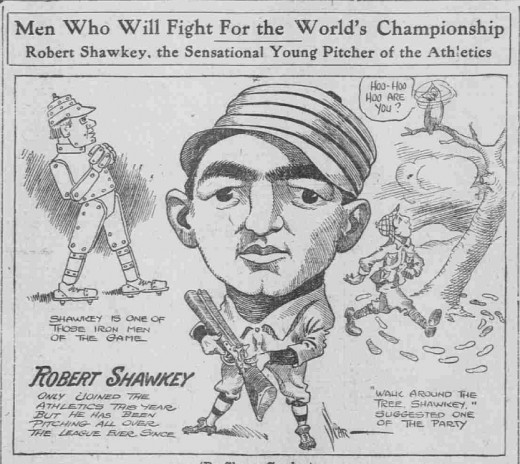
Shawkey Shucked
Bob Shawkey was a notable pitcher of the 1910s and 20s, even reigning as the Yankees’ career leader in wins from 1923 until Red Ruffing passed him in 1939.
By 1924, Shawkey was a part of five pennant winners. He debuted with the 1913 champs, the A’s, and immediately contributed, going 6-5 with a 2.34 ERA. When Philadelphia won the pennant again in 1914, Shawkey won 15 games. And when the A’s dynasty was disassembled, Shawkey went to the Yanks.
At just 25, he won 24 games in 1916, the first of four 20-win seasons in New York. Shawkey won at least 16 games every year from 1919 to 1924, including 54 during the team’s three pennants from 1921-3.
On Aug. 24, 1924, Shawkey relieved in a game against Dave Danforth and the Browns. He didn’t stay long. He faced two batters, walking one and retiring one. Then he was ejected for throwing a discolored ball.
Through that game, Shawkey pitched 30 times in 1924, with 19 starts, going 11-10 with a 5.05 ERA. When he returned, just a few days later (I suppose there was no suspension), Shawkey was much improved. The first outing was not so great, but the rest were ridiculously good. He ended up 5-1 with a 1.49 ERA the rest of the way.
It didn’t do much to prolong his career, however. The bottom fell out on the Yankees in 1925, and Shawkey was 6-14 with a 4.11 ERA. He was effective as a spot starter and reliever in 1926, then as a reliever for the 1927 champs before retiring. He ended up 195-150 with a 3.09 ERA.
Ptui! Potter Punted
The first ejection for a spitball came 20 years after Shawkey’s incident. Nelson Potter was enjoying his best year yet as most of the stars were serving in the military during World War II. The St. Louis Browns, long a joke, became the last of the 16 “original” teams to win a pennant in 1944, and Potter won 19 games for them.
Potter had bounced about the majors before 1944. He got into one game with the Cardinals in 1936, then returned to the bigs two years later with the A’s. It did not go well, but the A’s were bad enough to keep him around for three years. Potter went 2-12 with a 6.47 ERA in 1938, then 8-12 with a 6.60 and 9-14 with a 4.44.
After 10 more lousy games in 1941, he went to the Red Sox. Ten games later, he was done with them, too. The Browns took a gamble on him in 1943, and that’s when things turned around. Apparently, adding a slider and subtracting the best players was all he needed.
Potter went 10-5 with a 2.78 ERA, then started his career year before the ol’ spitter brought him some fame. After four innings, he was ejected on July 20. Potter was 9-5 in 20 games with a 3.21 ERA.
When his 10-day suspension ended, Potter emerged at an even higher level. He went 10-2, completing his last six starts, the final two as shutouts. His ERA in that stretch was 2.25. He allowed five runs in two starts in the World Series, but only one of them was earned.
Not surprisingly, Potter was pretty solid in 1945 as well, going 15-11 with a 2.47 ERA. After a so-so season, he finished up with three pretty decent seasons in relief for the Browns, A’s and Braves. He even helped the 1948 Braves make the World Series. For his career, Potter went 92-97 with a 3.99 ERA.
Rich Nye's Story?
- The State: The cue (Volume III, Issue 2): March 29, 1968 issue 2
From the Wisconsin archives, a little hint as to why Nye got into trouble.
No, No, Nye
This one is a bit tricky. For one thing, I’m having trouble coming up with a proper account of the incident, and the bits and pieces seem to make it all the more intriguing and beguiling.
What I do know is this: On April 27, 1968, the Cubs’ Rich Nye was ejected for using a spitball. Except that the boxscores I see only cite his manager, Leo Durocher, as being ejected. Huh?
There were six spitballs cited by umps. All accounts seem to agree on that. And there were two on Astros starter Dave Giusti, who pitched a complete game victory. Nye and two of his relievers, Bill Stoneman and Jack Lamabe, each were cited, as well, although I can’t tell who once and who twice. Or if anywhere ejected. Huh?
My initial guess was that Giusti was cited twice and Durocher, firebrand that he was, was so angry Giusti was allowed to keep pitching, so he ordered his pitchers to throw only spitballs to make a point and they kept getting caught. But I think Durocher was tossed in the first, and the relievers didn’t come in until the sixth.
Perhaps the best clue I’ve found so far is something from March 1968, through a Wisconsin state archive, of all places. Nye and Joe Niekro – who appears later on this list – are cited as two pitchers who always lick their fingers and wipe them before pitching. “Habits like these cannot be overcome overnight,” it says in the item, apparently from something called “The Cue,” or from the Chicago Tribune, as the item says information comes from there. It’s not very clear. Naturally.
This game was early in the season. Was Durocher trying to protest the hand licking rule with a staff full of lickers? In addition to Nye and Niekro, perhaps Stoneman and Lamabe, he had Phil Regan, a pitcher teammates later called a master spitballer. You’ll see him on this list very soon.
Anyway, it seems the umps called a ball each time a guy got caught. And Nye, already trailing 1-0 unraveled in the sixth, allowing a two-run single with one out and the bases loaded. He was taken out, but Stoneman and Lamabe allowed four more runs to score that inning.
Who really was a cheater here? Hard to tell if anyone was. For the purposes of this exercise, let’s just include Nye.
In his three April starts, Nye tallied just 9 1/3 innings and 12 runs, 10 of them earned. If he was suspended, it wasn’t for long. He was back on May 1. Nye tossed in another 24 games, going 7-10 with a save and 3.36 ERA. Not too bad.
For some perspective, since we’re jumping into his career later than in the above entries, Nye was a solid rookie for the Cubs in 1967. He pitched well in three games in 1966, then went 13-10 with a 3.20 ERA in his first full campaign. His 1968 wasn’t quite as solid. He bounced around afterward, with unimpressive results for the 1969 Cubs and 1970 Cardinals and Expos. He retired with a 26-31 record and 3.71 ERA.
The Vulture Gets Caught
- The Free Lance-Star - Google News Archive Search
The Associated Press' Hal Bock writes up the incident in which Regan was caught and Durocher and two other Cubs tossed.
Rioting Regan
When considering Regan’s incident, I think the Nye one provides some context. The Cubs were likely being viewed as potential spitball targets.
Known as “The Vulture,” Regan had emerged as an elite reliever by 1968. After modest results as a starter for the Tigers in the early 1960s, Regan’s performance dropped sharply in 1964 and 1965. He had 36 wins and improving ERAs from 1961-3, then went 5-10 with a 5.03 and 1-5 with a 5.05.
His career suddenly turned with a change of scenery. In Los Angeles, Regan went 14-1 with a 1.62 ERA and league-leading 21 saves in 1966 for the pennant-winning Dodgers. He was good, but not great, in 1967, then went to the Cubs after five games in 1968. There, Regan found himself again. He finished the year 12-5 with a 2.27 ERA and 25 saves.
Naturally, Durocher wanted to protect this guy from spitballing penalties. On Aug. 18, 1968, Regan came in and pitched three innings in relief of Nye. He completed the game, but was twice called for using Vaseline. The pitches were nullified. The second time, Pete Rose turned a strikeout into a single.
The great Associated Press writer Hal Bock wrote up a story that the (Fredericksburg, Va.) Free Lance-Star titled “‘Lawyers’ Lose Appeal on Regan’s Vaseline.” (I call him great because not only is he a respected writer, but he was very kind to me when I was a baseball clerk at the AP.) Bock called Regan “the sticky fingered vulture.”
He details how Durocher, Randy Hundley and Al Spangler were ejected for protesting in favor of Regan. In the seventh, Regan faced Mack Jones. With a 1-2 count, the ump warned Regan about illegal pitches and decided to change the count to 3-1. After Durocher complained, “the umpire and manager compromised on a 2-2 count.” A flyout was called back, however, and on the next pitch, Jones grounded out.
Durocher didn’t like that, either. He and Spangler were ejected as the umps wanted a towel to wipe off Regan’s cap. In the ninth, it happened again. Rose struck out, but the pitch was nullified and he then singled. Hundley complained and was ejected.
Regan whined, “The umpires are taking my livelihood away from me. I’m going to court about this.”
Regan was 10-2 with 20 saves at that point, along with a 1.93 ERA. He pitched again two days later. He wasn’t as effective the rest of the way, going 2-3 with five saves and a 3.58 ERA. Most of that ERA bump came from one bad outing, however.
Regan was fairly solid in 1969, going 12-6 with a 3.70 ERA and 17 saves. That was the end of his days as a relief ace, although he was pretty decent in his last three years. Regan finished at 96-81 with a 3.84 ERA and 92 saves.
Don Sutton
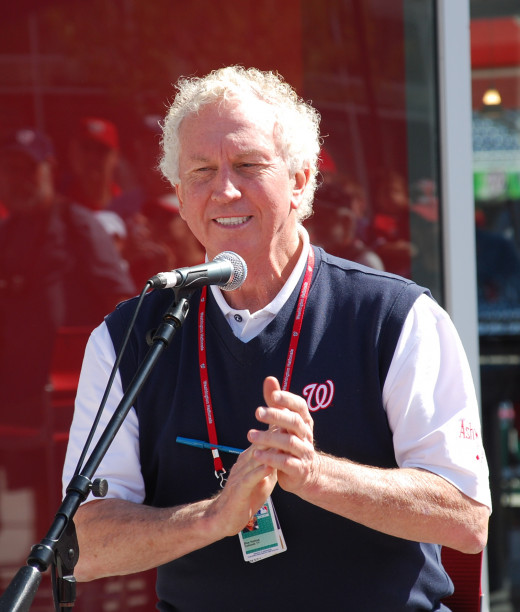
Scuffing Sutton
Nobody on this list won as many games as Don Sutton. When he was ejected in 1978, it was after a dozen years of solid pitching and before another decade of reliability.
Actually, he might have been ejected for cheating in 1977, although that’s not on the Retrosheet list I’ve been relying on. Check this out: http://www.truebluela.com/2013/1/22/3904282/don-sutton-gets-ejected
Sutton entered the 1978 season tied with Dazzy Vance for second in Dodgers history with 190 wins. He was within range of No. 1, Don Drysdale, at 209. He was also second in shutouts and innings. At 190-144 with a 3.04 ERA and more than 2,000 strikeouts, Sutton was already one of the more notable pitchers in the game’s history, if not the flashiest.
Sutton was having a decent, but unremarkable season for the NL champs in mid July, and after being ejected on July 14, he stood at 9-8 with a 3.87 in 19 starts.
Sutton was very glib about accusations of messing with the ball, as noted in the link above and this one, too: https://espn.go.com/page2/s/list/cheaters/ballplayers.html
He wasn’t, however, very jovial after being ejected. Umpire Doug Harvey related what happened to the LA Times’ Gordon Edes for the Oct. 14, 1986 edition, when rumors swirled around Houston’s Mike Scott.
Harvey said “he had three baseballs thrown by Sutton that were clearly scuffed. …
The umpire said he warned the pitcher after the second one and ejected him after the next.”
This quote is interesting: “‘Don Sutton ran into the dressing room and came out with a typewritten order,’ Harvey recalled. ‘He said, ‘You'll be hearing from my lawyer.’ I crumpled it up and told him where he could stick it.’”
Instead of a suspension, he was warned by the commissioner. The rest of the way, Sutton was more like his usual self, going 6-3 with a 3.18. He helped the team win another pennant, the fourth in his 13 years in Los Angeles.
And he kept on keeping on. Sutton passed Drysdale in 1979 and remains the team’s winningest pitcher. He was a huge part of several contenders, despite never winning a World Series title. He helped the Dodgers make it to a tiebreaker game in 1980, the Astros make the playoffs in 1981, the Brewers win their only pennant in 1982, the Angels to the division title in 1986, and returned home to the Dodgers only to be released two months before their championship in 1988. Along the way he totaled 324 wins against 256 losses, a 3.26 ERA and 3,574 strikeouts, enough to land him in the Hall of Fame.
As a child of the late 1970s, Don Sutton was probably the first pitcher I associated with “great.” Maybe it was Guidry or Ryan or Seaver, but I am pretty sure it was Sutton.
Rick Honeycutt
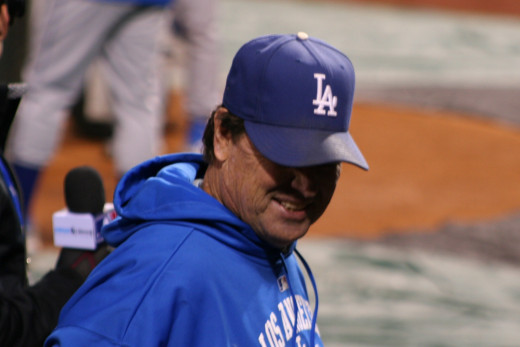
Honeycutter
I doubt any pitcher ejected for cheating had as much egg on his face as Rick Honeycutt, or as much to look forward to in his career.
Honeycutt debuted with the Seattle Mariners in 1977. And I do mean with, as it was the same year the team started play. He worked his way into the starting rotation in 1978 and was pretty much a non-descript starter by 1979. He had a good, albeit losing, year in 1980. He was making his final start of the season on Sept. 30 when he was kicked out in the third inning.
Honeycutt had a thumbtack taped to his finger. Baserunner Willie Wilson noticed this in the third inning, and the umps went to check it out. Honeycutt, forgetting about the tack, rubbed his forehead with his hand. Oops. He not only cut the ball, but his face. The suspension ended his season.
Honeycutt went 10-17 with a 3.94 ERA, doing his part for a bad team. He then went to Texas and turned his career around. Honeycutt went 11-6 with a 3.31 ERA in the strike-shortened season. After a very bad year in 1982, he went 14-8 for the Rangers, leading the league with a 2.42 ERA, then was traded down the stretch to the Dodgers. He finished at 16-11 with a 3.03 ERA and made the playoffs. He had three more decent starting seasons with L.A., making the playoffs again in 1985, before going to Oakland in the middle of a lousy year in 1987.
When Dennis Eckersley emerged as the closer supreme for the 1988 A’s, Honeycutt became the glue between Eck and the starting pitchers. He was a formidable reliever for Oakland for six years, through a title, three pennants and four playoff appearances. He then bounced around until 1997 with the Rangers, A’s, Yankees and Cardinals.
For his career, the ‘Cut went 109-143 with a 3.72 ERA and 38 saves.
Gaylord Perry
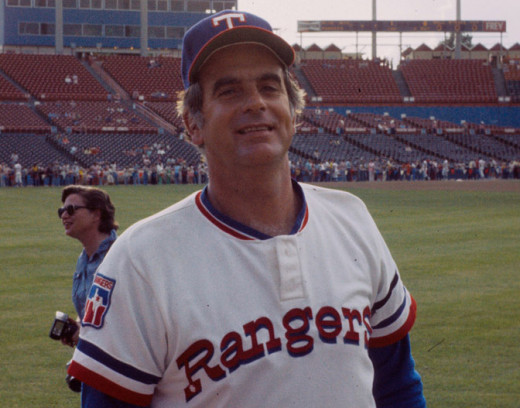
Perry Bad Behavior
Like Don Sutton, Gaylord Perry won more than 300 games and was long associated with cheating. But Perry was perhaps the most blatant user of the spitball in modern baseball history.
Like Rick Honeycutt, Perry was caught while with the early Mariners, but Perry was on the opposite end of his career. Perry had recently crossed the 300-win barrier, cementing his place with the all-time greats.
Now just a shell of his prior self, Perry was running on Vaseline-scented fumes. Perry broke in with the NL champion 1962 Giants. He spent a decade paired with Juan Marichal, a formidable twosome leading a club that always seemed to end up in second place. Perry went 134-109 with the Giants, twice winning more than 20 games.
Then he leaped about from bad team to bad team for another decade. The master spitter managed to win 20 three more times despite playing for sad sack squads in Cleveland, Texas and San Diego, then back in Texas. After a brief stop with the Yankees, he went to the Braves and Seattle, nearly complete in his cross-country trek of mediocrity.
The 1982 season would be Perry’s last as a 10-game winner. But at 43, he still had some tricks up his sleeve. Perhaps literally, although his cap seemed more likely. Perry won his 300th game in May, and was doing fairly well through June. He struggled in July and August, and on Aug. 23, when finally officially caught mid-game, he was 7-11 and his ERA was up to 4.51.
Perry was warned before being caught again and thrown out in the seventh inning. When he returned six days later, he struggled and lost his fourth straight decision. Yet the final few games of the year provided a mild turnaround. Perry won his last three decisions and pitched to a 3.86 ERA in the five games after the ejection.
Splitting time between the Mariners and Royals, he went 7-14 with a 4.64 ERA in his final campaign in 1983. He retired with 314 wins, 265 losses and a 3.11 ERA, along with 3,534 strikeouts. The numbers are very similar to Sutton, who played for much better teams.
I doubt I’m the only one who needed years to accept Perry’s incredible career, the remarkable work he did in San Francisco and the success he had for a decade with little support instead of the image of the slimy-looking, ineffective fogey thrown out of the game because he cheated when I was a kid.
Niekro's Secret Unravels
- Joe Niekro - YouTube
Joe Niekro plays coy, but it quickly becomes clear he was hiding something.
Niekro’s Rough Night
The Niekro brothers both did wondrous, strange things with a baseball. Phil won more than 300 games and made it to the Hall of Fame with his knuckleball. Joe won more than 200 games and won a spot in infamy because he didn’t just use a knuckleball.
As is the case with Sutton and Perry, Niekro was well along in his career when caught. Joe came up three years after Phil, debuting with the 1967 Cubs and winning 10 games. He joined the first-year Padres mid-season in 1969, then was part of Detroit’s 1972 division title team, and teamed up with his brother in 1973 in Atlanta.
After two decent years with the Braves, Niekro appeared bound for a non-descript career, known mostly as Phil’s brother. About to enter his 30s, he was 58-63 with a 3.93 ERA and stuck in the bullpen. Then the Astros bought him for $35,000 and kick-started his career.
It took some time, as Niekro slowly worked in more and more starts, finally breaking through in 1978 with 29 starts. He led the league with 21 wins in 1979, then won 20 in 1980. He remained a key part of the Astros’ rotation until late 1985, when he again joined Phil, this time with the Yankees.
By 1987, the Niekro brother era was about over. Joe was now starting in Minnesota, coming over from the Yankees midseason. On Aug. 3, his rough second half just got worse. He was 5-8 with a 4.54 ERA, but his reputation and pride were about to suffer. In the fourth inning, the Angels had the umpire check Niekro’s pockets. Niekro tried to remove and hide some sandpaper and a nail file that had been in his pocket, but failed to do so, knocking them to the ground.
Niekro further embarrassed himself later by trying to deny it, saying, “Momma raised no cheaters.”
Back on the mound four days later, his poor second half continued, despite pitching for the team that would win the World Series. He went 2-5 with a 7.43 ERA to finish the year.
Niekro only pitched five games in 1988, and it was a pitiful sendoff for the veteran, 1-1 with a 10.03 ERA. He retired at 221-204 with a 3.59 ERA.
That’s Just Gross
If you thought the Niekro incident would have warned others not to mess around that August, you would be right. If you thought it would stop them, well, you’d be wrong.
Kevin Gross became a key member of the Phillies’ rotation in his rookie year, 1983. The Phillies won the pennant, and Gross was still going every few days for the Phils when he was caught just a week after Niekro.
Gross was 39-36 with a 3.79 ERA coming into 1987. He was the very definition of average and dependable. When hitters knocked run scoring upward in 1987, Gross remained right around the average, with a 4.35 ERA, but his win-loss record suffered.
His ERA was actually rather higher in mid August. Gross was with a 4.77 ERA when he was caught in the fifth inning on Aug. 10. It was the third straight time he failed to go more than five innings. Like Niekro, he had sandpaper in his possession, this time hiding in the glove.
Gross returned the very next day, pitching the 13th inning for a victory, although he sat out the first 10 days of September. He pitched to a much more respectable 3.43 ERA the rest of the way, although going just 3-6.
Gross resumed his right-on-average pitching in 1988 and kept on going like that through 1994, with stops in Montreal and Los Angeles. Only in his last three years did his ERA really vary from the league average, skyrocketing well over 5 while he went 22-24 for the Rangers and Angels. Gross retired with a 142-158 record and 4.11 ERA.
Jay Howell
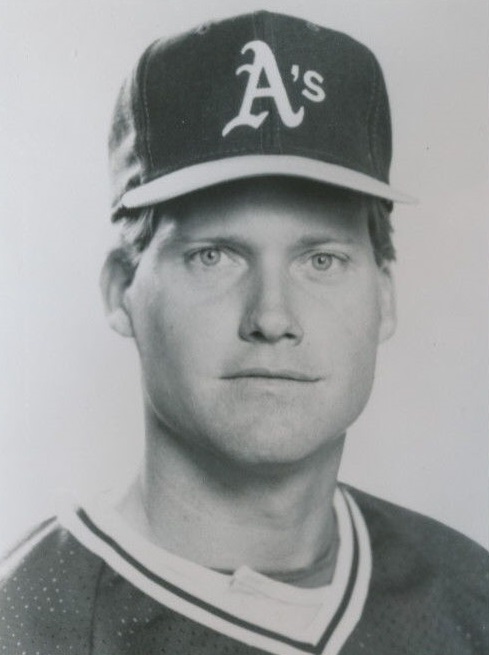
Howell ‘Bout That?
Jay Howell became the first player caught messing with the ball in the playoffs. Howell broke in with the Reds in 1980 and was well into a successful career when it happened in 1988.
Howell played briefly in Cincy, then Chicago and finally got his chance in New York in 1984. After 25 games with the Yankees over the previous two years, he became a key part of the team that year, pitching in 61 games with nine wins and a 2.69 ERA.
For the next three seasons, Howell served as the closer for the A’s, with 29 saves in 1985 and 16 each of the next two years. Then, just as Oakland returned to the World Series, Howell went to L.A. – and helped the Dodgers get there. He had an excellent season, going 5-3 with 21 saves and a 2.08 ERA.
In Game 3 of the NLCS, Howell was making his second appearance. Pine tar was found on his glove while facing his first batter, in the bottom of the eighth up 4-3. The walk was charged to him, and the Mets went on to score five runs. His next two appearances were in the World Series – a loss in Game 3 and a save in Game 4.
Howell remained the Dodgers’ closer for the next three years, with 60 saves and increasing ERAs: 1.58 to 2.18 to 3.18. He lost the job in 1992, but had a 1.54 ERA. He was effective for the Braves in 1993, then wrapped up with a poor performance in 1994 for the Rangers. He retired with a 58-53 record and 3.34 ERA, plus 155 saves.
Moehler Extracted
It was more than a decade before the next time a pitcher was ejected for cheating. Brian Moehler, who came up in 1996, made it to the Tigers’ rotation the next year. He was fairly sharp in 1998, going 14-13 with a 3.90 ERA in a poor pitching environment.
He hadn’t done much yet to indicate 1999 would be different when he got caught on May 1. It was his sixth start of the year, and he was caught with sandpaper in the seventh inning, leaving him with a 3-3 record and 4.23 ERA.
He didn’t come back from his suspension until May 14, and the results the rest of the way weren’t pretty. Moehler went 7-13 with a 5.24 ERA. He led the league in losses. Then he went 12-9 with a 4.50 in 2000.
Injuries basically knocked Moehler out of the 2001 season. He pitched one game that year, and only 16 more before joining the 2005 Marlins. He was a below-average pitcher for the next six years, two with Florida and four with Houston. He retired with a 84-107 record and 4.81 ERA.
Kim’s Illegal Heater
Diamondback fans thought young reliever Byung-Hyun Kim was hot stuff when the kid helped them to the 2001 World Series title. As a rookie two years earlier, however, he got into a situation too hot to handle.
Kim was called up in May 1999 and pitched a scoreless inning for a save in his debut on May 29. He was in his sixth game on June 9, having worked an inning, when a white object flew out of his uniform. It was a gooey item Kim claimed was a heat balm. Obviously, the umpires were less than pleased, and he got the old heave-ho.
Kim stayed with the big club through most of the summer, then returned in September, going 1-2 with a 4.87 ERA in 19 games. His strikeout total was an impressive 111 in 2000, and he racked up 14 saves despite a poor ERA. In 2001, he enjoyed a very strong season, with 113 strikeouts and 19 saves, helping the club win the championship.
Kim was just 23 when he reached his pinnacle in 2002, going 8-3 with a 2.04 ERA and 36 saves. Yet the team turned him into a starter in 2003. After seven starts, he went to Boston and went back to the bullpen. It was a pretty good year – 9-10, 3.31 ERA and 16 saves. He missed most of the team’s championship year in 2004, toiling in the minors, then pitched mostly as a starter for three years with the Rockies, Marlins and Diamondbacks, his ERAs mounting each year.
For his career, Kim went 54-60 with a 4.42 ERA and 86 saves.
Day's Take
- Baseball Prospectus | Prospectus Q&A: Zach Day
Zach Day describes what was going on when he was caught with superglue.
Day Unglued
Zach Day did not rely on the heater, literally or figuratively. He was all about the sinker. According to Day, it was due to blisters that his moment of infamy, in 2003, came about.
Day had a solid debut for the Expos in 2002, and was looking to follow it up early in 2003. He was 4-1 with a low 2.63 ERA. But there were blisters, and he claimed that’s why he needed to use superglue on his hand. After two innings, he was yanked.
Day wasn’t quite the same the rest of the year. He went 5-7 with a 5.28 ERA. He missed time with injuries, so it can’t be all laid to rest on a lack of superglue. He was moderately successful in 2004. When the Expos moved to Washington, Day’s success did not follow. He struggled with the Nationals, the Rockies and the Nationals again in 2005 and 2006, retiring with a 21-27 record and 4.66 ERA.
Julian Tavarez
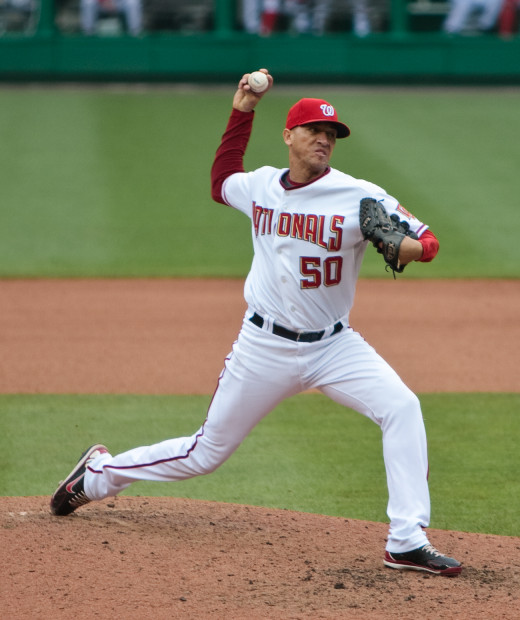
Tavarez Makes a Scene
- Cards reliever flips lid after dirty-hat ejection | The San Diego Union-Tribune
Julian Tavarez had to make a big show of it when he was ejected, trying to con the umps and then flipping his lid.
Tar-vares
Julian Tavarez had a long career, starting and relieving with many teams, several of them which made the playoffs.
Tavarez was a reliever for the Indians of the mid 1990s, then the Giants of the late 90s, two very strong clubs. The Rockies tried him as a starter a few times in 2000 then the Cubs and Marlins used him primarily in that role in 2001 and 2002. After going back to the pen with the Pirates in 2003, he came to St. Louis in 2004.
Under Tony LaRussa’s eye, Tavarez found himself in half the games over the next two seasons. He was having a very strong year in 2004, with a 2.57 ERA in 59 games after being ejected in the eighth inning of the first game of a doubleheader on Aug. 20.
Tavarez tried to sweet talk the umps into letting him go, then tossed his pine tar-stained cap into the stands. He was back for game 2.
In his next 18 games, Tavarez pitched to a 1.76 ERA. He then worked nine times in the postseason. He was a little less effective in 2005, then spent time in Boston both starting and relieving, not quite up to the same standard.
Tavarez went back to the bullpen in 2008, pitching for three teams before wrapping things up in Washington in 2009. He finished with an 88-82 record, 4.46 ERA and 23 saves.
Donnelly Dumped
Brendan Donnelly was one of several heaven-sent Angels rookies in 2002. His 2.17 ERA out of the bullpen helped the team win its only title. He remained effective over the next few seasons.
Donnelly struggled early in 2005, however. He was 4-2 with a 4.34 ERA when ejected on June 14. He didn’t even get to throw a pitch, thanks to the pine tar on his glove.
Donnelly managed to turn things around, going 5-1 with three saves and a 3.22 ERA the rest of the season. After a pretty good 2006, he bounced around, playing for Boston, Cleveland, Florida and Pittsburgh in successive seasons. He had ups, like a 1.78 ERA for the Marlins, and downs, like an 8.56 ERA for the Indians.
Donnelly went 32-10 with a 3.22 ERA for his career.
Rogers’ Reprieve
Kenny Rogers knew when to hold them and when to fold them. After all, this gambler cheated, got caught and got away with it. In the World Series, no less.
Rogers had one of those careers that seemed as bland as vanilla until you considered the entire scope of his journey. Maybe that’s why he got away with it in 2006.
Rogers came up with Texas in 1989, relieving effectively in 73 games. He had 10 wins and 15 saves in 1990 and led the league with 81 games in 1992. And then, just like that, his days as a reliever were over.
When Rogers became a starter in 1993, nobody could have foreseen that he would remain one for 16 years and end up with more than 200 career wins. He was OK, but nothing special, for the next two years, then had a breakout year in 1995, going 17-7 with a 3.38 ERA. And then came his odyssey, bouncing about from team to team, making the playoffs with four of them, but never Texas, despite five years in two additional stops there.
In 2006, Rogers went 17-8, his fifth straight year with at least 13 wins. He crossed the 200-win threshold, apparently ageless at 41. He beat two of his old clubs, the Yankees and A’s, in the playoffs, then went up against St. Louis in the World Series.
During the first inning, TV cameras showed muck on his hand. When the Cardinals had umps take a look before the second inning, his hand was clean. Rogers went eight scoreless innings, running his streak to 23 shutout playoff innings for the Tigers.
Rogers suffered injuries in 2007, going 3-4 with a 4.43 ERA. He went 9-13 with a 5.70 in 2008 before retiring. His final numbers were 219-156 with a 4.27 ERA.
Peralta Pines For More
Joel Peralta was the last guy to get thrown out of a game until Pineda came along. The reliever was moderately successful with the Angels and Royals from 2005 to 2007. He then struggled with the Royals in 2008 and Rockies in 2009.
Peralta turned things back around in 2010 with the Nationals and has done well since. In 2012, he was on his way to a second good year with the Rays. He had a 3.81 ERA on June 19 when he was caught with pine tar on his glove. He didn’t even get to throw a pitch.
He held hitters to just a .199 average the rest of the way, with a 3.49 ERA in 42 games. Peralta went 3-8 with a 3.41 ERA last year and appears to be himself again this year. At 38, he seems to be in a nice groove.
Before and After, Same Season Results
Name/Date
| G
| W-L
| IP
| K
| BB
| ERA
|
|---|---|---|---|---|---|---|
Sallee, 5/2-6/11/20
| 9
| 2-4
| 53 2/3
| 7
| 7
| 3.52
|
Sallee, 6/24-9/26/20
| 17
| 4-2
| 79 2/3
| 8
| 9
| 2.82
|
Danforth, 4/13-7/27/22
| 20
| 5-2
| 79 2/3
| 48
| 38
| 3.28
|
Danforth, Minors, 1922
| 10
| 6-4
| 90
| 15
| N/A
| N/A
|
Danforth, 4/18-8/1/23
| 24
| 10-6
| 128 2/3
| 54
| 46
| 3.50
|
Danforth, 8/16-10/5/23
| 14
| 6-8
| 97 2/3
| 42
| 41
| 4.52
|
Shawkey, 4/15-8/14/24
| 30
| 11-10
| 153 1/3
| 88
| 63
| 5.05
|
Shawkey, 8/27-9/23/24
| 8
| 5-1
| 54 1/3
| 26
| 11
| 1.49
|
Potter, 4/21-7/20/44
| 20
| 9-5
| 140
| 46
| 49
| 3.21
|
Potter, 8/6-9/29/44
| 12
| 10-2
| 92
| 45
| 21
| 2.25
|
Nye, 4/13-27/68
| 3
| 0-2
| 9 1/3
| 6
| 2
| 9.64
|
Nye, 5/1-9/18/68
| 24
| 7-10
| 123 1/3
| 68
| 32
| 3.36
|
Regan, 4/14-8/18/68
| 56
| 10-2
| 107
| 54
| 17
| 1.93
|
Regan, 8/20-9/29/68
| 17
| 2-3
| 27 2/3
| 13
| 8
| 3.58
|
Sutton, 4/7-7/14/78
| 19
| 9-8
| 128
| 76
| 24
| 3.87
|
Sutton, 7/18-10/1/78
| 15
| 6-3
| 110 1/3
| 78
| 30
| 3.18
|
Honeycutt, 1980
| 30
| 10-7
| 203 1/3
| 79
| 60
| 3.94
|
Honeycutt, 1981
| 20
| 11-6
| 127 2/3
| 40
| 17
| 3.31
|
Perry, 4/9-8/23/82
| 27
| 7-11
| 181 2/3
| 99
| 45
| 4.51
|
Perry, 8/29-9/27/82
| 5
| 3-1
| 35
| 17
| 9
| 3.86
|
Niekro, 4/12-8/3/87
| 19
| 5-8
| 107
| 63
| 44
| 4.54
|
Niekro, 8/7-10/4/87
| 8
| 2-5
| 40
| 21
| 19
| 7.43
|
Gross, 4/10-8/10/87
| 23
| 6-10
| 137 2/3
| 63
| 58
| 4.77
|
Gross, 8/11-10/3/87
| 11
| 3-6
| 63
| 47
| 29
| 3.43
|
Howell, 1988 NLCS
| 2
| 0-1
| 2/3
| 1
| 2
| 27.00
|
Howell, 1988 WS
| 2
| 0-1
| 2 2/3
| 2
| 1
| 3.33
|
Moehler, 4/5-5/1/99
| 6
| 3-3
| 38 1/3
| 19
| 8
| 4.23
|
Moehler, 5/14-9/27/99
| 26
| 7-13
| 158
| 87
| 51
| 5.24
|
Kim, 5/29-6/9/99
| 6
| 0-0
| 7
| 8
| 3
| 3.86
|
Kim, 6/12-10/2/99
| 19
| 1-2
| 20 1/3
| 23
| 17
| 4.87
|
Day, 4/2-5/17/03
| 9
| 4-1
| 54 2/3
| 26
| 24
| 2.63
|
Day, 5/23-9/24/03
| 14
| 5-7
| 76 2/3
| 35
| 35
| 5.28
|
Tavarez, 4/5-8/20/04
| 59
| 5-3
| 49
| 35
| 14
| 2.57
|
Tavarez, 8/20-10/3/04
| 18
| 2-1
| 15 1/3
| 13
| 5
| 1.76
|
Donnelly, 4/6-6/14/05
| 27
| 4-2
| 29
| 22
| 7
| 4.34
|
Donnelly, 6/17-10/2/05
| 39
| 5-1
| 36 1/3
| 31
| 12
| 3.22
|
Rogers, 2006 playoffs
| 3
| 3-0
| 23
| 19
| 7
| 0.00
|
Rogers, 2007
| 11
| 3-4
| 63
| 36
| 25
| 4.43
|
Peralta, 4/6-6/19/12
| 35
| 0-2
| 28 1/3
| 35
| 7
| 3.81
|
Peralta, 6/20-10/3/12
| 42
| 2-4
| 38 2/3
| 49
| 10
| 3.49
|
Before and after results for each pitcher, with before counting the ejection game, from the same season. Honeycutt and Rogers did not pitch again that season, so the next year is shown.
Conclusion
When you combine all the players caught and their pre- and post-caught numbers at 10 and 25 games before and after, you find that their performance, by and large, doesn’t change that much. A few more innings, a few more runs, a few more walks, a few more strikeouts, and the same ERA.
One area was surprisingly different by a large amount – their win-loss records. The players were 58-46 with a 3.71 ERA in the 10 games before and 61-58 with a 3.78 in the 10 games after. They were 142-116 with a 3.79 in the 25 games before and 134-138 with a 3.76 in the 25 games after.
So, does this mean anything? It shows up in both sets of data, and not a mild shift but a fairly strong one. It could be coincidence.
If there’s any conclusion to be drawn, it would be that a pitcher caught cheating is likely to be basically the same pitcher the rest of the year or next year, but to have worse luck winning games. Perhaps it isn’t the pitcher that changes, but the way the manager views him.
Actually, it’s more sensible that the way the pitcher is viewed would change than that the pitcher would change.

